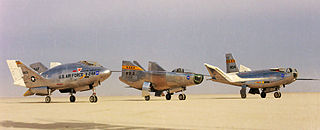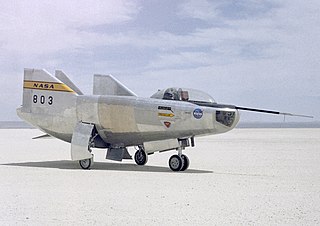
An aircraft is a vehicle that is able to fly by gaining support from the air. It counters the force of gravity by using either static lift or the dynamic lift of an airfoil, or, in a few cases, direct downward thrust from its engines. Common examples of aircraft include airplanes, helicopters, airships, gliders, paramotors, and hot air balloons.

A fixed-wing aircraft is a heavier-than-air flying machine, such as an airplane, which is capable of flight using wings that generate lift caused by the aircraft's forward airspeed and the shape of the wings. Fixed-wing aircraft are distinct from rotary-wing aircraft, and ornithopters. The wings of a fixed-wing aircraft are not necessarily rigid; kites, hang gliders, variable-sweep wing aircraft and airplanes that use wing morphing are all examples of fixed-wing aircraft.

A lifting body is a fixed-wing aircraft or spacecraft configuration in which the body itself produces lift. In contrast to a flying wing, which is a wing with minimal or no conventional fuselage, a lifting body can be thought of as a fuselage with little or no conventional wing. Whereas a flying wing seeks to maximize cruise efficiency at subsonic speeds by eliminating non-lifting surfaces, lifting bodies generally minimize the drag and structure of a wing for subsonic, supersonic and hypersonic flight, or spacecraft re-entry. All of these flight regimes pose challenges for proper flight safety.

The North American X-15 is a hypersonic rocket-powered aircraft operated by the United States Air Force and the National Aeronautics and Space Administration (NASA) as part of the X-plane series of experimental aircraft. The X-15 set speed and altitude records in the 1960s, crossing the edge of outer space and returning with valuable data used in aircraft and spacecraft design. The X-15's highest speed, 4,520 miles per hour, was achieved on 3 October 1967, when William J. Knight flew at Mach 6.7 at an altitude of 102,100 feet (31,120 m), or 19.34 miles. This set the official world record for the highest speed ever recorded by a crewed, powered aircraft, which remains unbroken.
The XLR11, company designation RMI 6000C4, was the first liquid-propellant rocket engine developed in the United States for use in aircraft. It was designed and built by Reaction Motors Inc., and used ethyl alcohol and liquid oxygen as propellants to generate a maximum thrust of 6,000 lbf (27 kN). Each of the four combustion chambers produced 1,500 lbf (6.7 kN) of thrust. The engine was not throttleable but each chamber could be turned on and off individually.

The Northrop X-4 Bantam was a prototype small twinjet aircraft manufactured by Northrop Corporation in 1948. It had no horizontal tail surfaces, depending instead on combined elevator and aileron control surfaces for control in pitch and roll attitudes, almost exactly in the manner of the similar-format, rocket-powered Messerschmitt Me 163 of Nazi Germany's Luftwaffe. Some aerodynamicists had proposed that eliminating the horizontal tail would also do away with stability problems at fast speeds resulting from the interaction of supersonic shock waves from the wings and the horizontal stabilizers. The idea had merit, but the flight control systems of that time prevented the X-4 from achieving any success.

The X-38 was an experimental re-entry vehicle designed by NASA to research a possible emergency crew return vehicle (CRV) for the International Space Station (ISS). The 1995–2002 program also developed concepts for a crew return vehicle design that could be modified for other uses, such as a possible joint U.S. and international human spacecraft that could be launched on the French Ariane 5 booster.

William Harvey Dana was an American aeronautical engineer, U.S. Air Force pilot, NASA test pilot, and astronaut. He was one of twelve pilots who flew the North American X-15, an experimental spaceplane jointly operated by the Air Force and NASA. He was also selected for participation in the X-20 Dyna-Soar program.

Milton Orville Thompson, , better known as Milt Thompson, was an American naval officer, aviator, engineer, and NASA research pilot. He was one of twelve pilots who flew the North American X-15, an experimental spaceplane jointly operated by the United States Air Force and NASA.

A rocket-powered aircraft or rocket plane is an aircraft that uses a rocket engine for propulsion, sometimes in addition to airbreathing jet engines. Rocket planes can achieve much higher speeds than similarly sized jet aircraft, but typically for at most a few minutes of powered operation, followed by a gliding flight. Unhindered by the need for oxygen from the atmosphere, they are suitable for very high-altitude flight. They are also capable of delivering much higher acceleration and shorter takeoffs. Many rocket aircraft may be drop launched from transport planes, as take-off from ground may leave them with insufficient time to reach high altitudes.

The Northrop HL-10 was one of five US heavyweight lifting body designs flown at NASA's Flight Research Center in Edwards, California, from July 1966 to November 1975 to study and validate the concept of safely maneuvering and landing a low lift-over-drag vehicle designed for reentry from space. It was a NASA design and was built to evaluate "inverted airfoil" lifting body and delta planform. It currently is on display at the entrance to the Armstrong Flight Research Center at Edwards Air Force Base.

The NASA M2-F1 was a lightweight, unpowered prototype aircraft, developed to flight-test the wingless lifting body concept. Its unusual appearance earned it the nickname "flying bathtub" and was designated the M2-F1, the M referring to "manned", and F referring to "flight" version. In 1962, NASA Dryden management approved a program to build a lightweight, unpowered lifting-body prototype. It featured a plywood shell placed over a tubular steel frame crafted at Dryden. Construction was completed in 1963.

The Northrop M2-F2 was a heavyweight lifting body based on studies at NASA's Ames and Langley research centers and built by the Northrop Corporation in 1966.

The Northrop M2-F3 was a heavyweight lifting body rebuilt from the Northrop M2-F2 after it crashed at the Dryden Flight Research Center in 1967. It was modified with an additional third vertical fin - centered between the tip fins - to improve control characteristics. The "M" refers to "manned" and "F" refers to "flight" version.

A supersonic aircraft is an aircraft capable of supersonic flight, that is, flying faster than the speed of sound. Supersonic aircraft were developed in the second half of the twentieth century. Supersonic aircraft have been used for research and military purposes, but only two supersonic aircraft, the Tupolev Tu-144 and the Concorde, ever entered service for civil use as airliners. Fighter jets are the most common example of supersonic aircraft.

A glider is a fixed-wing aircraft that is supported in flight by the dynamic reaction of the air against its lifting surfaces, and whose free flight does not depend on an engine. Most gliders do not have an engine, although motor-gliders have small engines for extending their flight when necessary by sustaining the altitude with some being powerful enough to take off by self-launch.

Jerauld Richard "Jerry" Gentry was a United States Air Force (USAF) test pilot and Vietnam combat veteran. As chief USAF pilot of the Lifting Body Research Program, he helped validate the concept of flying a wingless vehicle back to Earth from space and landing it like an aircraft—an approach used by the Space Shuttle and to a greater degree by vehicles such as the Lockheed Martin X-33 and NASA X-38. Gentry completed thirty lifting body flights including the first flight of the Martin-Marietta X-24A and the second flight of the Northrop HL-10.

A drop test is a method of testing the in-flight characteristics of prototype or experimental aircraft and spacecraft by raising the test vehicle to a specific altitude and then releasing it. Test flights involving powered aircraft, particularly rocket-powered aircraft, may be referred to as drop launches due to the launch of the aircraft's rockets after release from its carrier aircraft.

SNC Demo-1, also known as Dream Chaser Demo-1, is the planned first flight of the Sierra Nevada robotic resupply spacecraft Dream Chaser to the International Space Station (ISS) under the CRS-2 contract with NASA. The demonstration mission is planned for launch in June 2024 on the second flight of the ULA Vulcan Centaur rocket. Sierra Nevada Corporation (SNC) developed a new reusable spacecraft to provide commercial cargo resupply services to the International Space Station (ISS), based on decades of lifting body programs. Under the Commercial Orbital Transportation System (COTS) program, SNC designed Dream Chaser with industrial partner Lockheed Martin. SNC also designed the accompanying Shooting Star cargo module with subcontractor Applied Composites. At the end of mission, the Shooting Star will destructively reenter the atmosphere and the Dream Chaser will land at the Kennedy Space Center's Shuttle Landing Facility.






















